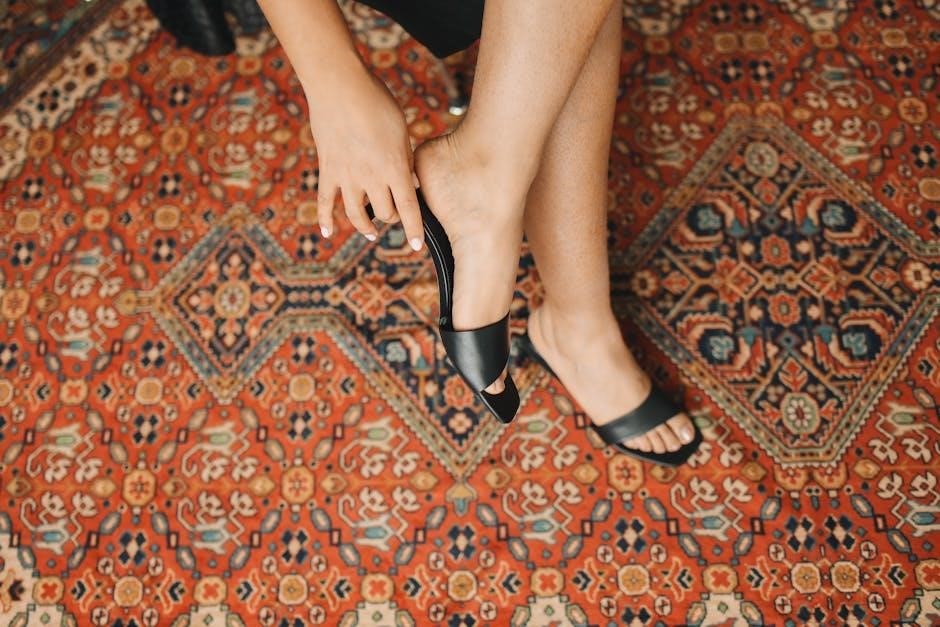
Discover the fun and creative way to transform fabric strips into a beautiful‚ functional rug. This free PDF pattern offers easy instructions for all skill levels‚ perfect for crafting a personalized‚ colorful rug using jelly roll strips. Ideal for home decor‚ it combines practicality with artistic expression‚ allowing you to customize size‚ shape‚ and design effortlessly.
What is a Jelly Roll Rug?
A Jelly Roll Rug is a creative DIY project that transforms pre-cut fabric strips‚ known as jelly rolls‚ into a functional and decorative rug. Typically made by coiling or spiraling the fabric strips and stitching them together‚ these rugs can be customized in various shapes‚ sizes‚ and colors. They often include batting for added thickness and comfort‚ making them both visually appealing and durable. Perfect for home decor‚ Jelly Roll Rugs can be placed in entryways‚ sewing rooms‚ or beside beds‚ offering a charming‚ handmade touch to any space.
Why Choose a Jelly Roll Rug Pattern?
A Jelly Roll Rug pattern is an excellent choice for crafters seeking a fun and rewarding DIY project. It offers a unique way to repurpose fabric strips into a functional and decorative item. The pattern is beginner-friendly‚ requiring minimal sewing skills‚ and allows for endless customization. With a free PDF‚ you can easily access the instructions and start creating immediately. This project is perfect for those who enjoy upcycling fabric and adding a personal touch to home decor. It’s also a great way to practice sewing techniques while making something truly useful and beautiful.
Benefits of Using a Free PDF Pattern
Using a free PDF pattern for your Jelly Roll Rug offers numerous advantages. It provides instant access to the design‚ allowing you to start your project immediately. The digital format is environmentally friendly and eliminates the need for physical storage. You can easily print the pattern or view it on your device. Free PDFs are cost-effective and perfect for crafters on a budget. They also allow you to experiment with the design without financial commitment‚ making it a great option for beginners or those looking to try a new technique.
Materials and Tools Needed
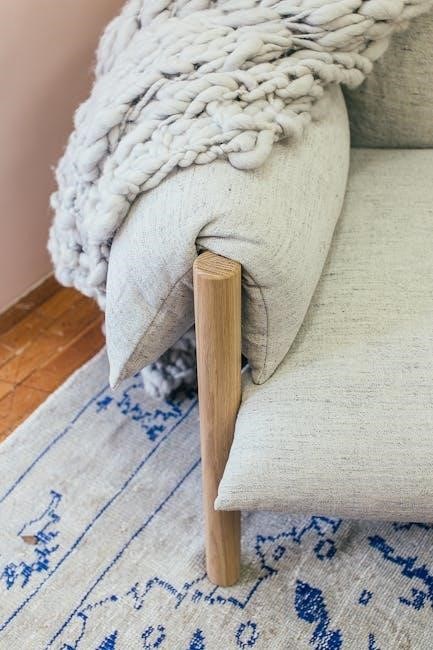
A jelly roll rug requires jelly roll fabric strips‚ cotton batting‚ a sewing machine‚ rotary cutter‚ mat‚ ruler‚ and thread. A free PDF pattern is instantly downloadable.
Jelly Roll Fabric Strips
Jelly roll fabric strips are pre-cut‚ 2.5-inch-wide strips of coordinated fabric‚ ideal for creating a jelly roll rug. They come in various colors and patterns‚ saving time on cutting fabric. These strips are designed to work seamlessly together‚ ensuring a cohesive look. Their consistent width helps the rug lie flat and prevents bunching. Jelly rolls are perfect for beginners‚ as they eliminate the need to match fabrics. Simply sew the strips together‚ following the pattern’s instructions‚ to create a vibrant and professional-looking rug. Their convenience and variety make them a must-have for this project.
Cotton Batting
Cotton batting is a thin‚ insulating layer placed between the fabric strips and the backing of the rug. It adds thickness‚ stability‚ and a soft‚ cushioned feel. High-quality cotton batting is breathable and durable‚ ensuring the rug remains comfortable and long-lasting. When using a free PDF pattern‚ choose batting specifically designed for quilting or home decor projects. It is essential to cut the batting to the correct size and smooth out wrinkles before sewing to ensure a professional finish and prevent shifting during use.
Sewing Machine and Notions
A reliable sewing machine is essential for constructing a Jelly Roll Rug. Use a standard sewing machine with a straight-stitch or zigzag setting to secure the fabric strips. Necessary notions include sharp rotary cutters‚ scissors‚ and heavy-duty needles. Thread should match the fabric colors to blend seamlessly. Pins and a sewing gauge are useful for aligning strips accurately. A walking foot or even-feed attachment can help manage thick fabric layers. Ensure all tools are prepped to streamline the sewing process and achieve a professional finish.
Other Essential Tools
Besides fabric and sewing supplies‚ several tools are crucial for crafting a Jelly Roll Rug. A rotary cutter and mat are ideal for trimming excess fabric. Measuring tools like rulers and tape measures ensure accuracy. Ironing tools‚ such as a mini iron or travel-sized iron‚ help press seams flat. Fabric clips or clamps are handy for managing strips during construction. A design wall or board can aid in arranging patterns. Lastly‚ storage bins or baskets keep materials organized. These tools enhance efficiency and precision in creating a stunning rug.
Understanding the Jelly Roll Rug Pattern
Understanding the pattern involves interpreting symbols‚ diagrams‚ and instructions for fabric cutting and assembly. It guides you through strip placement and stitching techniques for a professional finish.
Reading the Pattern Instructions
Reading the pattern instructions is crucial for success. Start by reviewing the entire document to understand the project scope and requirements. Pay attention to diagrams‚ symbols‚ and written guidelines for fabric strip preparation and assembly. The instructions will outline the sequence of steps‚ from cutting fabric to stitching strips together. Look for tips on managing fabric flow and aligning strips properly. Ensure you understand measurements and seam allowances to maintain consistency. Following the instructions carefully will help you achieve a professional-looking rug with minimal errors.
Choosing the Right Fabric
Selecting the appropriate fabric is essential for creating a jelly roll rug. High-quality quilting cotton is ideal due to its durability and ease of cleaning. Jelly rolls typically consist of 2.5-inch strips‚ so ensure your fabric aligns with this size. Opt for a fabric line that complements your home decor‚ using coordinating colors and patterns for visual interest. Check the pattern for yardage requirements and consider fabric weight—quilting cotton is medium-weight‚ suitable for rugs. Pre-wash fabric to prevent shrinkage and ensure it meets care instructions for the best results.
Preparing the Fabric Strips
Begin by cutting your fabric into 2.5-inch-wide strips‚ ensuring they are straight and evenly sized. Use a rotary cutter and mat for precision. Remove any selvage edges to prevent bulkiness. Iron each strip to eliminate wrinkles‚ making them lie flat. Arrange the strips in the desired order‚ considering color placement and pattern flow. Trim any excess fabric to match the required length specified in your pattern. Accurately prepared strips ensure a smooth sewing process‚ so double-check your measurements before proceeding.

Step-by-Step Construction Guide
Start by creating the spiral base‚ then stitch fabric strips together‚ shaping as you go. Add batting for thickness and finish with a secure binding.
This method ensures a sturdy‚ professional-looking rug using your Jelly Roll strips effectively.
Creating the Spiral or Coil Base
Begin by folding one fabric strip into a tight coil‚ securing it with a few hand stitches or pins. Use your sewing machine to stitch the center in place‚ ensuring it lies flat. Gradually add more strips‚ sewing them together in a spiral pattern‚ and gently pull the fabric to form the desired shape. For even tension‚ use a walking foot or guide the fabric smoothly. This step sets the foundation for the rug’s structure and shape‚ so take your time to keep it aligned and flat.

Stitching the Fabric Strips Together
Align the fabric strips with right sides together‚ ensuring edges are even. Use a 1/4-inch seam allowance to sew them in a continuous spiral‚ maintaining consistent tension to prevent puckering. As you sew‚ gently guide the fabric to keep the strips aligned and flat. Since the strips are pre-cut‚ there’s no need for additional piecing. Use a walking foot for smooth feeding‚ and backstitch at the start and end of each seam for durability. Keep stitches even and steady to ensure a professional finish.
Shaping the Rug
As you sew the strips together‚ gently coil or spiral them to form the rug’s shape. Start with a tight center coil‚ gradually increasing the size as you add more strips. Smooth and adjust the fabric as you go to maintain a uniform shape and prevent wrinkles. Use a ruler or mat to guide the edges‚ ensuring the rug lies flat. This step requires patience to achieve a polished‚ professional finish. Keep the edges aligned and the spiral even for a visually appealing result.
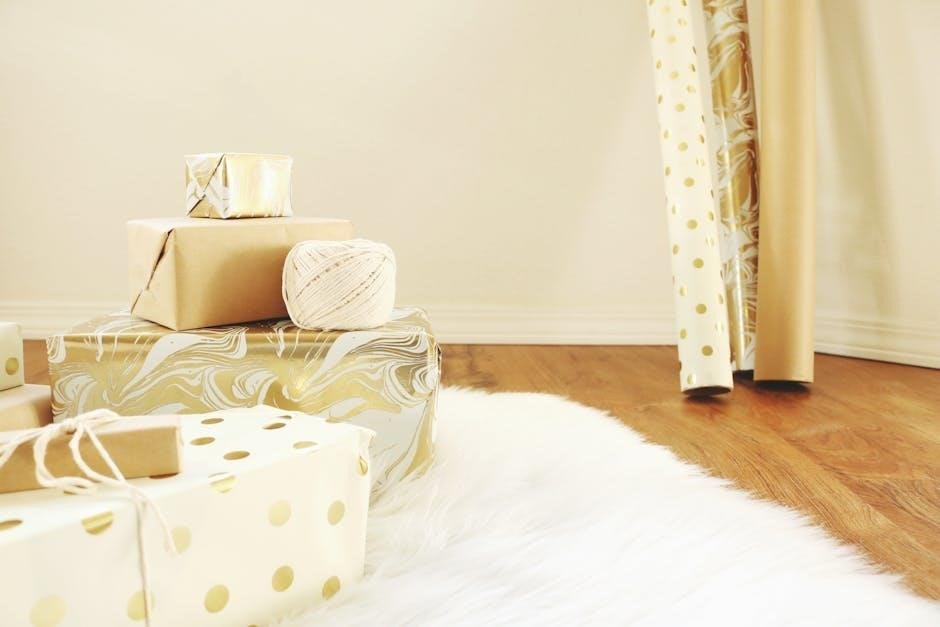
Adding the Batting
Cut the cotton batting to match the size of your rug. Place it evenly between the fabric layers‚ ensuring full coverage. Smooth out any wrinkles or air pockets to prevent bunching. Secure the batting by pinning or spraying with a light adhesive. This step adds stability‚ comfort‚ and insulation to your rug. Make sure the batting aligns perfectly with the edges of the fabric for a professional finish. Properly placed batting enhances the rug’s durability and ensures a soft‚ cushioned surface.
Customizing Your Jelly Roll Rug
Personalize your rug by experimenting with fabric selection‚ colors‚ and patterns. Tailor the design to match your home decor or personal style for a unique touch.
Choosing Different Shapes and Sizes
Explore creative possibilities by selecting various shapes and sizes for your jelly roll rug. While traditional rugs are circular or oval‚ you can experiment with hexagons‚ squares‚ or rectangles for a modern twist. Sizes can range from small‚ coaster-like designs to large‚ floor-covering rugs. The size often depends on the number of jelly roll strips used‚ allowing flexibility for customization. A standard rug typically measures 30-40 inches in diameter‚ but you can adjust by adding or removing strips. This flexibility makes the pattern adaptable to any room or decor style‚ ensuring a perfect fit and unique appearance.
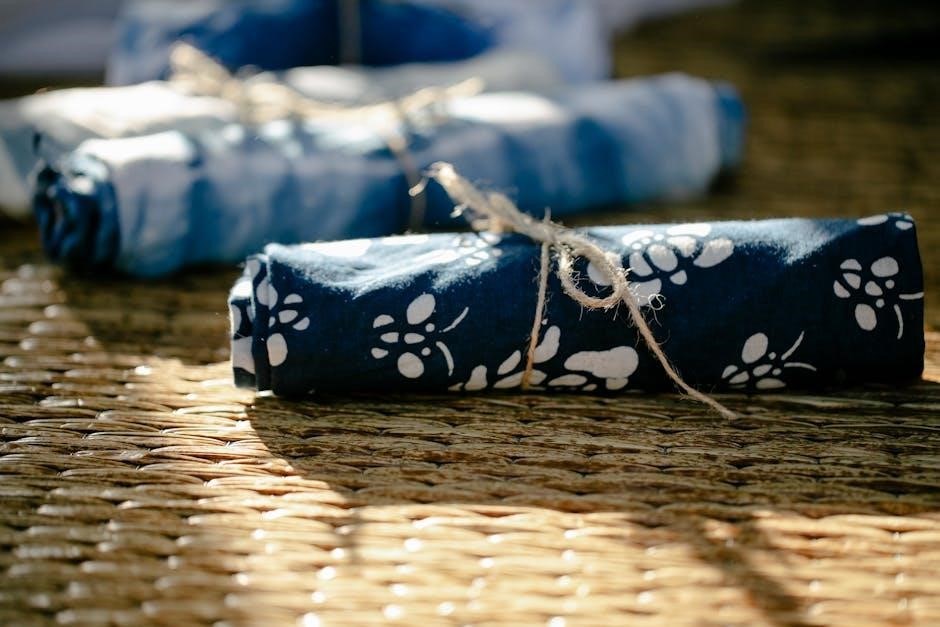
Adding Decorative Elements
Enhance your jelly roll rug by incorporating decorative elements like embroidery‚ appliques‚ or intricate stitching patterns. These embellishments add texture‚ depth‚ and visual interest‚ making your rug truly unique. Simple or complex designs can be used‚ depending on your skill level and desired aesthetic. This allows you to personalize the rug‚ ensuring it complements your home decor while reflecting your creativity. The result is a functional and artistic piece that stands out in any room‚ offering both style and comfort.
Using Different Colors and Patterns
Experimenting with various colors and patterns adds personality to your jelly roll rug. By selecting strips that complement your home decor‚ you can create a cohesive or vibrant look. Mixing solids‚ prints‚ and textures enhances visual appeal. Consider coordinating colors for a harmonious design or contrasting hues for a bold statement. The flexibility of jelly roll fabrics allows you to tailor the rug to match any room’s style‚ ensuring it becomes a unique and eye-catching element in your space while maintaining functionality.
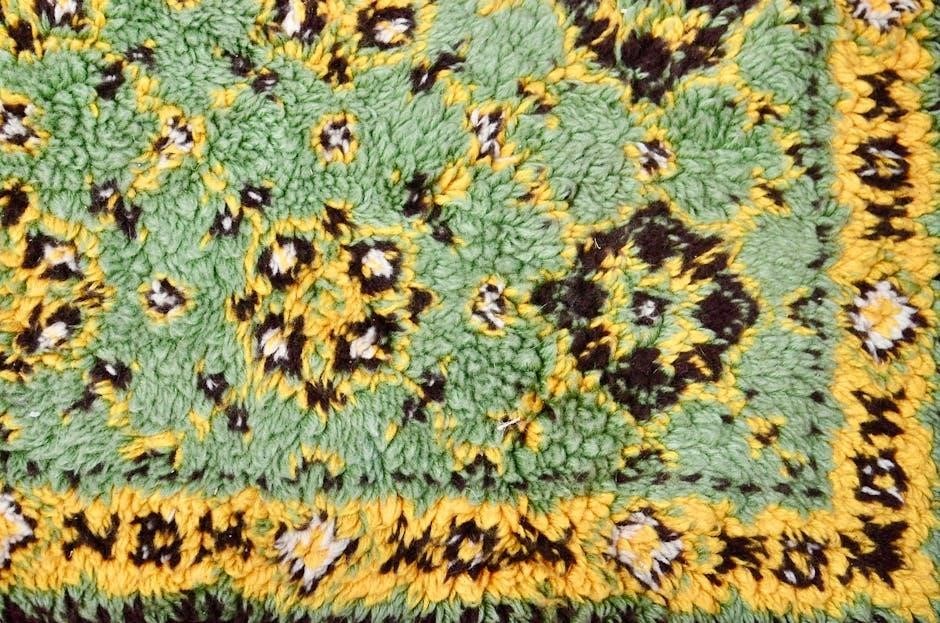
Tips and Tricks for Success
Mastering your jelly roll rug project requires careful planning‚ precise sewing‚ and patience. Use high-quality materials‚ follow pattern instructions closely‚ and maintain consistent tension while stitching for professional results.
Ironing and Managing Fabric Strips
Properly ironing and organizing your jelly roll fabric strips is essential for a smooth sewing process. Start by ironing each strip to remove wrinkles‚ ensuring they lie flat. Use a steam setting for stubborn creases but avoid scorching the fabric. Once ironed‚ manage the strips by winding them onto a cardboard or pegboard to prevent tangles. This step saves time and reduces frustration. Consider clipping strips together in the order you plan to sew them‚ ensuring a seamless workflow. This preparation enhances accuracy and efficiency in your jelly roll rug project.
Avoiding Common Mistakes
To ensure a professional-looking jelly roll rug‚ it’s crucial to avoid common mistakes. Start by verifying that all fabric strips are of consistent width to maintain an even appearance. Properly align patterns on printed fabrics to prevent a messy look. Check your sewing machine’s tension to avoid puckering or a loose weave. Accurately cut batting to fit seamlessly inside the rug‚ using sharp tools for clean edges. Always press seams as you go to eliminate bulk and ensure a smooth finish. Select a beginner-friendly pattern and carefully follow instructions to avoid confusion. Allow ample time to complete the project without rushing‚ as haste can lead to carelessness. By addressing these potential pitfalls‚ you’ll achieve a beautiful and professional result.
Maintaining Tension While Sewing
Maintaining consistent tension while sewing is vital for a professional-looking jelly roll rug. Proper tension ensures the fabric lies flat and prevents puckering or loose stitches. Adjust your sewing machine’s tension settings to accommodate the thickness of the jelly roll strips. Use a walking foot or Teflon foot to guide the fabric smoothly. Keep the fabric strips aligned and gently feed them through the machine without pulling too tightly. Consistent movement and steady pressure will help maintain even tension throughout the project for a polished finish.

Care and Maintenance
Regular vacuuming and spot cleaning with mild detergent maintain the rug’s appearance. Avoid direct sunlight to prevent fading and store the rug flat or rolled to prevent creases.
Cleaning Your Jelly Roll Rug
Cleaning your jelly roll rug is essential to maintain its appearance and durability. For spot cleaning‚ use a mild detergent and lukewarm water‚ gently blotting the area with a clean cloth. Avoid harsh chemicals or abrasive scrubbers‚ as they may damage the fabric. For deeper cleaning‚ hand wash the rug in cold water with a mild soap‚ then air dry flat. Regular vacuuming with a gentle suction setting can also help remove dust and dirt. Avoid machine washing or drying‚ as it may shrink or distort the rug. Apply a fabric protector to repel stains and extend its life.
Storing the Rug
Proper storage is key to preserving your jelly roll rug’s quality. Ensure the rug is clean and completely dry before storing to prevent mold or mildew. Roll the rug neatly and place it in a breathable fabric cover or cotton bag to protect it from dust. Avoid folding‚ as it may cause creases. Store in a cool‚ dry area away from direct sunlight to prevent fading. For long-term storage‚ consider using acid-free tissue paper or a protective quilt bag. Label the bag with the date and contents for easy identification.
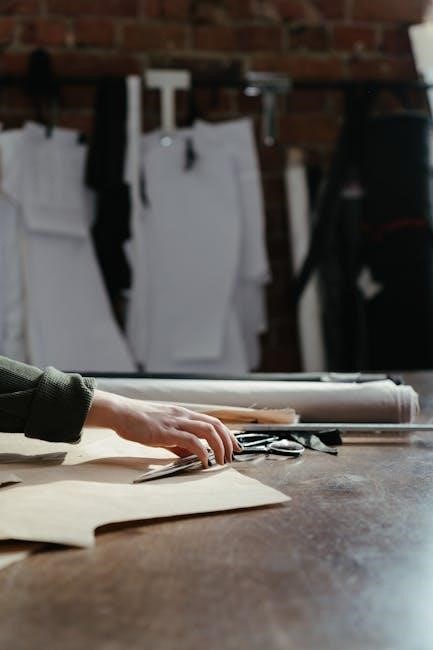
Extending the Life of Your Rug
To extend the life of your jelly roll rug‚ regular maintenance is essential. Vacuum gently to remove dirt and debris‚ and spot clean stains immediately with mild detergent. Avoid exposing the rug to harsh chemicals or direct sunlight‚ as this can fade colors. Rotate the rug periodically to ensure even wear. Place felt pads under furniture legs to prevent friction damage. For high-traffic areas‚ consider adding a non-slip backing. Store the rug in a cool‚ dry place when not in use‚ using breathable materials to prevent moisture buildup. Regular care ensures your rug remains vibrant and durable for years.
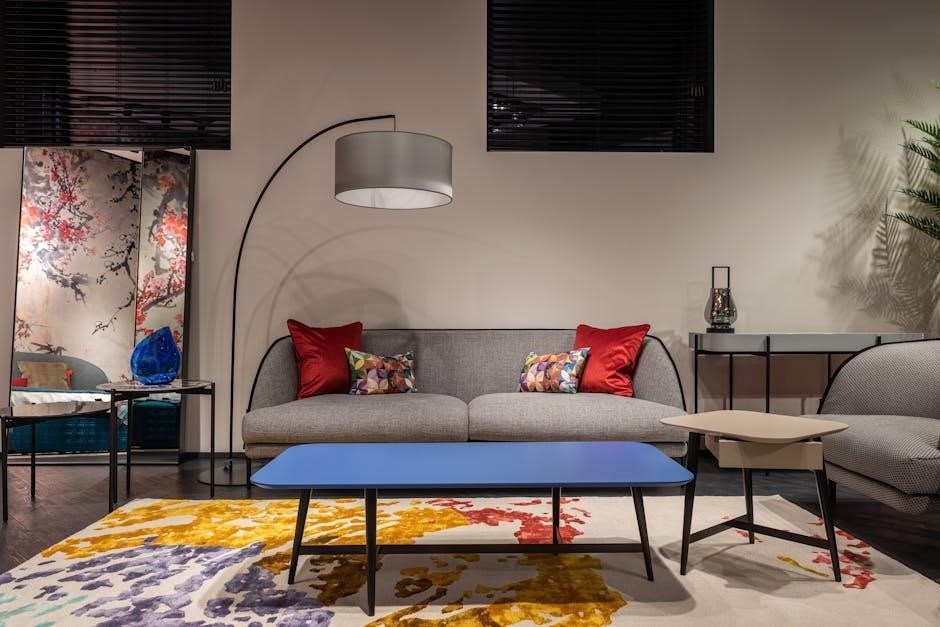
Advanced Techniques
Explore layering fabrics for depth‚ advanced stitching patterns‚ and decorative embellishments to elevate your jelly roll rug project and expand your creative possibilities.
Layering and Quilting
Layering fabrics and adding quilting enhances durability and texture. Use batting between layers for extra comfort and stitch intricate patterns for visual interest. This advanced technique transforms your rug into a stunning‚ professional-grade piece. Follow the PDF pattern’s guidance for layering tips and quilting designs. Ensure even stitching and proper tension for a polished finish. Quilting adds structural integrity while showcasing your creativity‚ making your jelly roll rug truly unique and long-lasting.
Adding Embellishments
Embellishments like appliques‚ embroidery‚ or decorative stitching can elevate your jelly roll rug. Use fabric paint‚ beads‚ or ribbon to add personality. Appliques cut from contrasting fabrics create vibrant designs‚ while embroidery floss offers intricate details. For a cohesive look‚ choose embellishments that match your rug’s color scheme. Apply fabric glue or sew them in place for durability. These decorative touches make your rug unique. Follow the PDF pattern’s tips for placement and techniques to ensure a professional finish without overwhelming the design.
Creating Placemats and More
Transform your jelly roll rug pattern into functional placemats and additional home decor items. Use fabric strips to create coiled or layered designs‚ then shape them into rectangular placemats. Add a backing fabric for a polished look and topstitch for durability. Experiment with contrasting strips for borders or appliques for visual interest. Consider making matching coasters or table runners for a cohesive table setting. Follow the PDF guide for material selection and techniques to craft unique‚ protective placemats that enhance your dining experience.
Community and Resources
Join online sewing communities‚ forums‚ and social media groups to share ideas and learn from experts. Utilize free tutorials‚ webinars‚ and downloadable guides for tips and inspiration.
Online Tutorials and Videos
Explore a wealth of free online tutorials and videos that guide you through creating a Jelly Roll Rug. These resources offer step-by-step instructions‚ tips‚ and tricks to help you master the pattern. Many tutorials include visual demonstrations‚ making it easier to understand complex techniques. Platforms like YouTube and crafting websites provide accessible content to enhance your skills. Additionally‚ some tutorials are accompanied by free downloadable PDF guides‚ ensuring you have all the tools needed to complete your project successfully.
Joining Sewing Communities
Connecting with sewing communities is a great way to enhance your Jelly Roll Rug project. Online forums‚ social media groups‚ and guilds offer valuable support and inspiration. Many communities share tips‚ answer questions‚ and showcase finished projects. Joining these groups allows you to troubleshoot common issues‚ learn new techniques‚ and gain confidence. Platforms like Facebook groups‚ Reddit forums‚ and specialized sewing communities are excellent places to connect with fellow crafters. Sharing your progress and learning from others can make your sewing journey more enjoyable and rewarding.
Sharing Your Project
Sharing your Jelly Roll Rug project is a wonderful way to showcase your creativity and connect with others. Whether through social media platforms like Instagram or Facebook‚ or by blogging about your experience‚ sharing your work can inspire others and provide valuable feedback. Consider posting high-quality photos of your rug in different settings to highlight its beauty. Including details about your design choices and challenges can also make your story more engaging. Don’t hesitate to share your accomplishments and join conversations about your unique creation!
A Jelly Roll Rug is a creative‚ practical project. Using a free PDF pattern‚ craft a unique‚ handmade rug that enhances any space. Start your project today and enjoy the satisfaction of creating something beautiful and functional.
Final Thoughts on Jelly Roll Rugs
Creating a Jelly Roll Rug is a rewarding and straightforward project‚ perfect for crafters of all skill levels. With a free PDF pattern‚ you can explore endless design possibilities while repurposing fabric strips. The process is both meditative and creative‚ allowing you to craft a unique‚ functional piece for your home. Whether you’re a seasoned sewer or a beginner‚ this project offers a sense of accomplishment and the joy of handmade craftsmanship. Dive in‚ experiment with colors‚ and enjoy the journey of making something truly special.
Encouragement to Start Your Project
Don’t hesitate to begin your Jelly Roll Rug journey! With a free PDF pattern‚ you’ll have clear guidance to follow. This project is perfect for all skill levels‚ allowing you to express your creativity while learning new techniques. Embrace the process‚ experiment with colors‚ and enjoy the satisfaction of creating something unique. Every stitch brings you closer to a beautiful‚ functional piece that reflects your personal style. Gather your materials‚ stay inspired‚ and let your creativity shine—your handmade rug awaits!